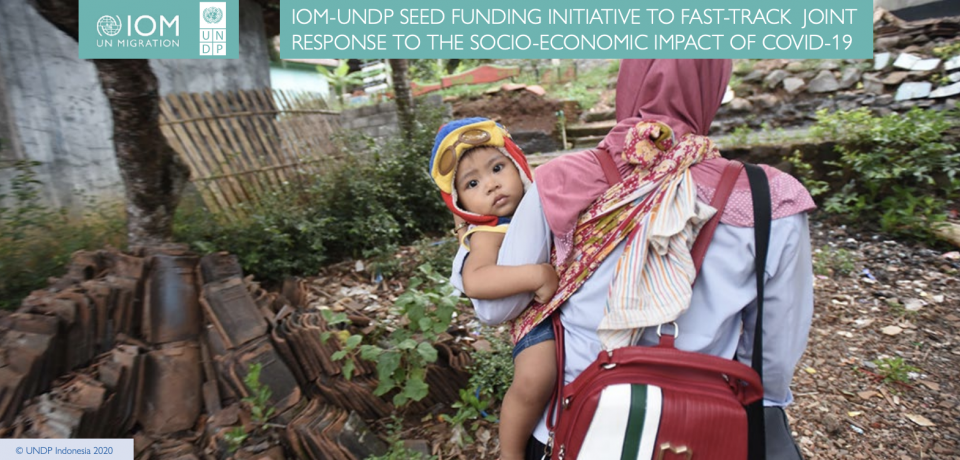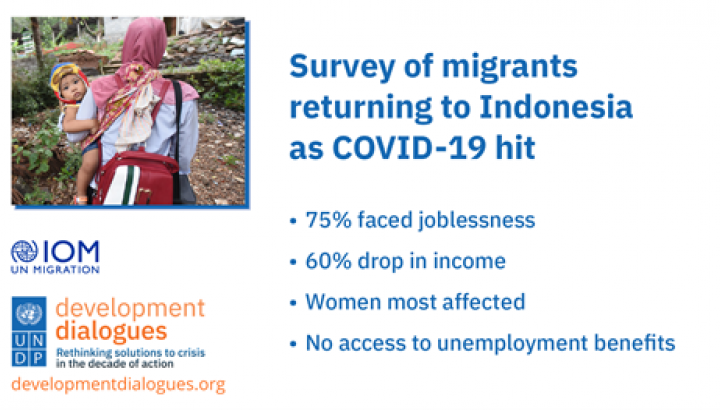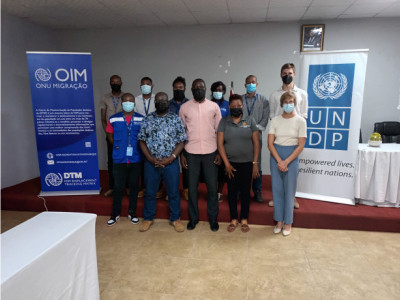Supporting evidence-based programming at the village level for addressing the socio-economic impact of COVID-19 on Indonesian migrant worker households
Norimasa Shimomura, Resident Representative, UNDP Indonesia, norimasa.shimomura@undp.org
Louis Hoffmann, Chief of Mission, IOM Indonesia, lhoffmann@iom.int
Related Sustainable Development Goals and Global Compact for Migration Objectives
Summary
In Indonesia, IOM and UNDP worked together to contribute to the Government of Indonesia’s (GOI) efforts to address the socio-economic impact of COVID-19 in Indonesia, especially among migrant worker households. Return migration was a significant trend in many countries around the world during the COVID-19 pandemic, as migrants lost their jobs and restrictions on mobility made migration more challenging and, often, dangerous; in 2020 alone, an estimated 180,000 Indonesian migrant workers returned to their communities of origin.
With the support of this seed funding initiative, IOM and UNDP conducted a complementary study to identify the needs, capacity and support mechanisms in migrant worker villages of origin, to identify opportunities for the inclusion of migrant worker households into existing development programming.
This project is part of the IOM-UNDP seed funding initiative to fast-track joint response to the socio-economic impact of COVID-19.
Key objective
The objective of the initiative was to build an evidence base to address the socio-economic impact of COVID-19 in Indonesia, especially among migrant worker households, through a study. The study aimed to understand the situation of returnees, thereby gathering best practices and lessons learned on COVID-19 responses for migrant workers and their families to support the migration governance and development frameworks in the country.
Main activities
With the support of this seed funding initiative, IOM and UNDP conducted a study to identify the needs, capacity and support mechanisms in migrant worker villages of origin, to identify opportunities for the inclusion of migrant worker households into existing development programming. The study employed a quantitative survey covering 1,082 villages across eight provinces. The study and its policy recommendations will contribute evidence-based data and information that can be used as a foundation to further support the GOI in formulating gender-sensitive policies and programmes to better protect and empower migrant worker households.
Key successes or innovative factors, good practices and lessons learned (if available)
The pandemic resulted in the repatriation of migrant workers at an unprecedented scale. Local governments face new challenges in implementing a response to migration. In addition, the majority of villages surveyed do not fully comprehend the law on the protection of Indonesian migrant workers (Law No.18 of 2017), which affects the availability of related regulations and programming at the village level for the protection and empowerment of migrant workers. More technical capacity support is needed from the national government to equip provincial, district and village governments with capabilities to implement the law.
The findings show that
- 75% of returning migrants faced joblessness.
- 60% experienced a drop in income.
- Women were the most affected.
- Most returning migrants had no access to unemployment benefits.
A coordinated national response and supportive budgetary framework is a good practice and has enabled the inclusion of migrant workers and their families in villages’ policy measures. Rather than establishing migration as a specific category, integration into the existing blueprints is a more suitable approach for including migration within the developmental framework. Aside from avoiding additional programmatic priorities which potentially overwhelm the village, this integration approach is also meant to avoid the instrumentalization and further politicization of migration.
The pandemic has necessitated village-based measures to register and collect data on returnees, which could serve as a stepping stone towards a more integrated migration database that includes the national and village levels. Better data collection on migration further supports the inclusion of migrant workers in the pandemic response and overall development programming.
Beneficiaries
Migrant workers and their households, local authorities


